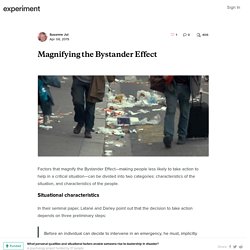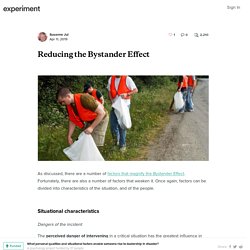

Yet, the reality is that the average person is less likely to provide help to someone who needs it when there are other bystanders present. This social phenomenon is called the Bystander Effect.
Background Image Credit: <a href=" from <a href="
What Is the Bystander Effect?
If you witnessed an emergency happening right before your eyes, you would certainly take some sort of action to help the person in trouble, right?

While we might all like to believe that this is true, psychologists suggest that whether or not you intervene might depend upon the number of other witnesses present. What Is the Bystander Effect? The term bystander effect refers to the phenomenon in which the greater the number of people present, the less likely people are to help a person in distress. When an emergency situation occurs, observers are more likely to take action if there are few or no other witnesses. Being part of a large crowd makes it so no single person has to take responsibility for an action (or inaction).
In a series of classic studies, researchers Bibb Latané and John Darley found that the amount of time it takes the participant to take action and seek help varies depending on how many other observers are in the room. The Science of Empathy. The Bystander Effect - You Can Break the Cycle. Are We Victims Of "Bystander Effect"? Collapsing in Public - The Bystander Effect (Social Experiment)
The smoke filled room study. Magnifying the Bystander Effect. Factors that magnify the Bystander Effect—making people less likely to take action to help in a critical situation—can be divided into two categories: characteristics of the situation, and characteristics of the people.

Situational characteristics In their seminal paper, Latané and Darley point out that the decision to take action depends on three preliminary steps: Before an individual can decide to intervene in an emergency, he must, implicitly or explicitly, take several preliminary steps. If he is to intervene, he must first notice the event, he must then interpret it as an emergency, and he must decide that it is his personal responsibility to act. [4] Characteristics of the situation may influence individual decisions at each of these three steps.
Number of people present The most significant factor in whether an individual will initiate action in a critical situation is the number of people present. Situational ambiguity Communication options. Reducing the Bystander Effect. As discussed, there are a number of factors that magnify the Bystander Effect.

Fortunately, there are also a number of factors that weaken it. Once again, factors can be divided into characteristics of the situation, and of the people. Situational characteristics Dangers of the incident The perceived danger of intervening in a critical situation has the greatest influence in reducing the Bystander Effect. Several explanations could account for the role of perceived danger. Most fundamentally, the arousal: cost–reward model suggests that taking action is a response to the physiological arousal engendered by a critical situation, and that … bystanders intervene in part because they seek to reduce their own arousal [1] Presumably, bystanders experience stronger arousal the more dangerous they perceive the situation to be, making the reward for intervening—in terms of reducing arousal—correspondingly greater.
Bystander Effect: If You Need Help, You'd Better Ask For It. Picture this.

You’re out hiking in the wilderness—all alone and miles from civilization. You turn a corner on the trail and come upon a young man in torn clothes, looking disheveled and a little incoherent. You’re on your way to your campsite, but he clearly needs help. As you approach, he explains he broke his leg, he’s been in the woods for days, and that he’d appreciate it if you could carry him, even just a few meters, to help him get back to the trailhead. What do you do? If you’re a half-decent person, I can guess you chose the first option: to stop and help. So, not only do you help, you probably cancel your plans and help carry the guy all the way back. Now, picture this. You’re dressed up and walking downtown to your first day at a new job.
Halfway there, you see a homeless man holding a sign: “Down on my luck. Do you stop to give him your change, or do you continue to work? Bystander Effect: Someone Else’s Problem.